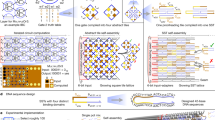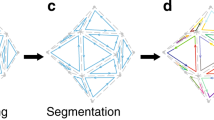Abstract
Self-assembly is a process in which basic units aggregate under attractive forces to form larger compound structures. Recent theoretical work has shown that pseudo-crystalline self-assembly can be algorithmic, in the sense that complex logic can be programmed into the growth process [26]. This theoretical work builds on the theory of two-dimensional tilings [8], using rigid square tiles called Wang tiles [24] for the basic units of self-assembly, and leads to Turing-universal models such as the Tile Assembly Model [28]. Using the Tile Assembly Model, we show how algorithmic self-assembly can be exploited for fabrication tasks such as constructing the patterns that define certain digital circuits, including demultiplexers, RAM arrays, pseudowavelet transforms, and Hadamard transforms. Since DNA self-assembly appears to be promising for implementing the arbitrary Wang tiles [30,13] needed for programming in the Tile Assembly Model, algorithmic self-assembly methods such as those presented in this paper may eventually become a viable method of arranging molecular electronic components [18], such as carbon nanotubes [10,1], into molecular-scale circuits.
Access this chapter
Tax calculation will be finalised at checkout
Purchases are for personal use only
Preview
Unable to display preview. Download preview PDF.
Similar content being viewed by others
References
Bachtold, A., Hadley, P., Nakanishi, T., Dekker, C.: Logic circuits with carbon nanotube transistors. Science 294, 1317–1320 (2001)
Beauchamp, K.G.: Walsh Functions and Their Applications. Academic Press, London (1975)
Boncheva, M., Gracias, D.H., Jacobs, H.O., Whitesides, G.M.: Biomimetic selfassembly of a functional asymmetrical electronic device. PNAS 99(8), 4937–4940 (2002)
Carbone, A., Seeman, N.C.: Circuits and programmable self-assembling DNA structures. PNAS 99(20), 12577–12582 (2002)
Cheng, Q., de Espanes, P.M.: Resolving two open problems in the self-assembly of squares. Usc computer science technical report #03-793, University of Southern California (2003)
Collier, C.P., Wong, E.W., Belohradsky, M., Raymo, F.M., Stoddart, J.F., Kuekes, P.J., Williams, R.S., Heath, J.R.: Electronically configurable molecularbased logic gates. Science 285, 391–394 (1999)
Gracias, D.H., Tien, J., Breen, T.L., Hsu, C., Whitesides, G.M.: Forming electrical networks in three dimensions by self-assembly. Science 289, 1170–1172 (2000)
Grünbaum, B., Shephard, G.C.: Tilings and Patterns. W.H. Freeman and Company, New York (1987)
Harmuth, H.F.: Applications of walsh functions in communications. IEEE Spectrum 6, 82–91 (1969)
Huang, Y., Duan, X., Cui, Y., Lauhon, L.J., Kim, K.-H., Lieber, C.M.: Logic gates and computation from assembled nanowire building blocks. Science 294, 1313–1317 (2001)
Jacobs, H.O., Tao, A.R., Schwartz, A., Gracias, D.H., Whitesides, G.M.: Fabrication of a cylindrical display by patterned assembly. Science 296, 323–325 (2000)
Lagoudakis, M.G., LaBean, T.H.: 2D DNA self-assembly for satisfiability. In: Winfree, E., Gifford, D.K. (eds.) DNA Based Computers V. DIMACS, vol. 54, pp. 141–154. American Mathematical Society, Providence (2000)
Mao, C., LaBean, T.H., Reif, J.H., Seeman, N.C.: Logical computation using algorithmic self-assembly of DNA triple-crossover molecules. Nature 407(6803), 493–496 (2000)
Pease, A.R., Jeppesen, J.O., Stoddart, J.F., Luo, Y., Collier, C.P., Heath, J.R.: Switching devices based on interlocked molecules. Acc. Chem. Res. 34, 433–444 (2001)
Pigeon, S., Bengio, Y.: Binary pseudowavelets and applications to bilevel image processing. In: Data Compression Conference (DCC 1999), pp. 364–373 (1999)
Pratt, W., Kane, J., Andrews, H.: Hadamard transform image coding. Proceedings of the IEEE 57(1), 58–68 (1969)
Puente-Baliarda, C., Romeu, J., Pous, R., Cardama, A.: On the behavior of the sierpinski multiband fractal antenna. IEEE Transactions on Antennas and Propagation 46(4), 517–524 (1998)
Robinson, B.H., Seeman, N.C.: The design of a biochip: A self-assembling molecular-scale memory device. Protein Engineering 1(4), 295–300 (1987)
Rothemund, P.W.K.: Using lateral capillary forces to compute by self-assembly. PNAS 97, 984–989 (2000)
Rothemund, P.W.K., Winfree, E.: The program size complexity of selfassembled squares. In: Symposium on the Theory of Computing, STOC 2000 (2000)
Sylvester, J.J.: Thoughts on orthogonal matrices, simultaneous sign-successions, and tessellated pavements in two or more colours, with applications to newton’s rule, ornamental tile-work, and the theory of numbers. Phil. Mag. 34, 461–475 (1867)
Tzafestas, S.G.: Walsh Functions in Signal and Systems Analysis and Design. Van Nostrand Reinhold, New York (1985)
Walsh, J.L.: A closed set of normal orthogonal functions. Amer. J. Math. 45, 5–24 (1923)
Wang, H.: Proving theorems by pattern recognition. II. Bell System Technical Journal 40, 1–42 (1961)
Williams, K.A., Veenhuizen, P.T., de la Torre, B.G., Eritja, R., Dekker, C.: Carbon nanotubes with DNA recognition. Nature 420, 761 (2002)
Winfree, E.: On the computational power of DNA annealing and ligation. In: Lipton, R.J., Baum, E.B. (eds.) DNA Based Computers. DIMACS, vol. 27, pp. 199–221. American Mathematical Society, Providence (1996)
Winfree, E.: Algorithmic Self-Assembly of DNA. PhD thesis, California Institute of Technology, Computation and Neural Systems Option (1998)
Winfree, E.: Simulations of computing by self-assembly. Technical Report CSTR: 1998.22, Caltech (1998)
Winfree, E.: Algorithmic self-assembly of DNA: Theoretical motivations and 2D assembly experiments. Journal of Biomolecular Structure & Dynamics, 263–270 (2000) (special issue S2)
Winfree, E., Liu, F., Wenzler, L.A., Seeman, N.C.: Design and self-assembly of two-dimensional DNA crystals. Nature 394, 539–544 (1998)
Yarlagadda, R., Hershey, J.: Hadamard Matrix Analysis and Synthesis With Applications to communications and Signal/Image Processing. Kluwer Academic Publishers, Boston (1997)
Author information
Authors and Affiliations
Editor information
Editors and Affiliations
Rights and permissions
Copyright information
© 2004 Springer-Verlag Berlin Heidelberg
About this paper
Cite this paper
Cook, M., Rothemund, P.W.K., Winfree, E. (2004). Self-Assembled Circuit Patterns. In: Chen, J., Reif, J. (eds) DNA Computing. DNA 2003. Lecture Notes in Computer Science, vol 2943. Springer, Berlin, Heidelberg. https://doi.org/10.1007/978-3-540-24628-2_11
Download citation
DOI: https://doi.org/10.1007/978-3-540-24628-2_11
Publisher Name: Springer, Berlin, Heidelberg
Print ISBN: 978-3-540-20930-0
Online ISBN: 978-3-540-24628-2
eBook Packages: Springer Book Archive




